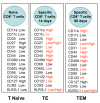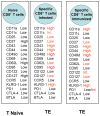Relevance of long-lived CD8(+) T effector memory cells for protective immunity elicited by heterologous prime-boost vaccination
- PMID: 23264773
- PMCID: PMC3525016
- DOI: 10.3389/fimmu.2012.00358
Relevance of long-lived CD8(+) T effector memory cells for protective immunity elicited by heterologous prime-boost vaccination
Abstract
Owing to the importance of major histocompatibility complex class Ia-restricted CD8(+) T cells for host survival following viral, bacterial, fungal, or parasitic infection, it has become largely accepted that these cells should be considered in the design of a new generation of vaccines. For the past 20 years, solid evidence has been provided that the heterologous prime-boost regimen achieves the best results in terms of induction of long-lived protective CD8(+) T cells against a variety of experimental infections. Although this regimen has often been used experimentally, as is the case for many vaccines, the mechanism behind the efficacy of this vaccination regimen is still largely unknown. The main purpose of this review is to examine the characteristics of the protective CD8(+) T cells generated by this vaccination regimen. Part of its efficacy certainly relies on the generation and maintenance of large numbers of specific lymphocytes. Other specific characteristics may also be important, and studies on this direction have only recently been initiated. So far, the characterization of these protective, long-lived T cell populations suggests that there is a high frequency of polyfunctional T cells; these cells cover a large breadth and display a T effector memory (TEM) phenotype. These TEM cells are capable of proliferating after an infectious challenge and are highly refractory to apoptosis due to a control of the expression of pro-apoptotic receptors such as CD95. Also, they do not undergo significant long-term immunological erosion. Understanding the mechanisms that control the generation and maintenance of the protective activity of these long-lived TEM cells will certainly provide important insights into the physiology of CD8(+) T cells and pave the way for the design of new or improved vaccines.
Keywords: CD8; adenovirus; memory; vaccines.
Figures



Similar articles
-
Heterologous plasmid DNA prime-recombinant human adenovirus 5 boost vaccination generates a stable pool of protective long-lived CD8(+) T effector memory cells specific for a human parasite, Trypanosoma cruzi.Infect Immun. 2011 May;79(5):2120-30. doi: 10.1128/IAI.01190-10. Epub 2011 Feb 28. Infect Immun. 2011. PMID: 21357719 Free PMC article.
-
Perforin and gamma interferon expression are required for CD4+ and CD8+ T-cell-dependent protective immunity against a human parasite, Trypanosoma cruzi, elicited by heterologous plasmid DNA prime-recombinant adenovirus 5 boost vaccination.Infect Immun. 2009 Oct;77(10):4383-95. doi: 10.1128/IAI.01459-08. Epub 2009 Aug 3. Infect Immun. 2009. PMID: 19651871 Free PMC article.
-
CD4 and CD8 T cell responses to the M. tuberculosis Ag85B-TB10.4 promoted by adjuvanted subunit, adenovector or heterologous prime boost vaccination.PLoS One. 2009;4(4):e5139. doi: 10.1371/journal.pone.0005139. Epub 2009 Apr 9. PLoS One. 2009. PMID: 19357780 Free PMC article.
-
Strategies and implications for prime-boost vaccination to generate memory CD8 T cells.Adv Exp Med Biol. 2011;780:69-83. doi: 10.1007/978-1-4419-5632-3_7. Adv Exp Med Biol. 2011. PMID: 21842366 Review.
-
Recalling the Future: Immunological Memory Toward Unpredictable Influenza Viruses.Front Immunol. 2019 Jul 2;10:1400. doi: 10.3389/fimmu.2019.01400. eCollection 2019. Front Immunol. 2019. PMID: 31312199 Free PMC article. Review.
Cited by
-
Polymorphism of formyl peptide receptor 1 (FPR1) reduces the therapeutic efficiency and antitumor immunity after neoadjuvant chemoradiotherapy (CCRT) treatment in locally advanced rectal cancer.Cancer Immunol Immunother. 2021 Oct;70(10):2937-2950. doi: 10.1007/s00262-021-02894-8. Epub 2021 Mar 13. Cancer Immunol Immunother. 2021. PMID: 33713152 Free PMC article.
-
Heterologous Prime-Boost Vaccination with a Peptide-Based Vaccine and Viral Vector Reshapes Dendritic Cell, CD4+ and CD8+ T Cell Phenotypes to Improve the Antitumor Therapeutic Effect.Cancers (Basel). 2021 Dec 3;13(23):6107. doi: 10.3390/cancers13236107. Cancers (Basel). 2021. PMID: 34885215 Free PMC article.
-
Genetic vaccination against experimental infection with myotropic parasite strains of Trypanosoma cruzi.Mediators Inflamm. 2014;2014:605023. doi: 10.1155/2014/605023. Epub 2014 Jun 26. Mediators Inflamm. 2014. PMID: 25061263 Free PMC article.
-
Vaccination using recombinants influenza and adenoviruses encoding amastigote surface protein-2 are highly effective on protection against Trypanosoma cruzi infection.PLoS One. 2013 Apr 24;8(4):e61795. doi: 10.1371/journal.pone.0061795. Print 2013. PLoS One. 2013. PMID: 23637908 Free PMC article.
-
CD8(+) T cell-mediated immunity during Trypanosoma cruzi infection: a path for vaccine development?Mediators Inflamm. 2014;2014:243786. doi: 10.1155/2014/243786. Epub 2014 Jul 1. Mediators Inflamm. 2014. PMID: 25104879 Free PMC article. Review.
References
-
- Acierno P. M., Schmitz J. E., Gorgone D. A., Sun Y., Santra S., Seaman M. S., et al. (2006). Preservation of functional virus-specific memory CD8+ T lymphocytes in vaccinated, simian human immunodeficiency virus-infected rhesus monkeys. J. Immunol. 176 5338–5345 - PubMed
-
- Ahmed R., Akondy R. S. (2011). Insights into human CD8+ cell memory using the yellow fever and smallpox vaccines. Immunol. Cell Biol. 89 340–345 - PubMed
-
- Aidoo M., Otten R. A., Rodriguez V., Sariol C. A., Martinez M., Kraiselburd E., et al. (2007). Absence of SHIV infection in gut and lymph node tissues in rhesus monkeys after repeated rectal challenges following HIV-1 DNA/MVA immunizations. Vaccine 25 6474–6481 - PubMed
-
- Akram A., Inman R. D. (2012). Immunodominance: a pivotal principle in host response to viral infections. Clin. Immunol. 143 99–115 - PubMed
-
- Amara R. R., Villinger F., Altman J. D., Lydy S. L., O’Neil S. P., Staprans S. L., et al. (2001). Control of a mucosal challenge and prevention of AIDS by a multiprotein DNA/MVA vaccine. Science 292 69–74 - PubMed
LinkOut - more resources
Full Text Sources
Research Materials
Miscellaneous

